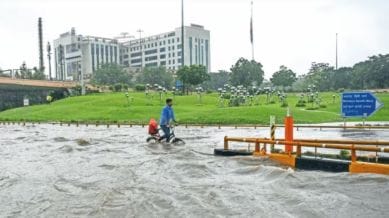Stay updated with the latest - Click here to follow us on Instagram
What experts say on Delhi Drainage Master Plan 2025
Two eminent experts welcome drainage plan, suggest ways to improve delivery

On September 19, Union Minister for Housing and Urban Affairs Manohar Lal unveiled a Rs 57,000 crore Delhi Drainage Master Plan 2025, a 30-year solution for urban flooding that aims to reduce instances of waterlogging and flooding by 50% in the next five years.
Here’s what experts say about the plan
monthly limit of free stories.
with an Express account.
‘Positive step, but focus on wetlands, using modern tech would help’: A K Jain
It is a positive step. Finally, after nearly 50 years, a Drainage Master Plan has been finalised. The last such plan was made in 1976, when the population of Delhi was just 30 lakh; it’s now more than seven times that number.
This new plan has been prepared rather quickly. Notably, it has altered fundamental aspects like drainage boundaries — earlier there were six drainage basins, they have now been merged into three. However, drainage systems can’t be confined within administrative boundaries.
The plan has used the expression nature-based solutions. This is not a new concept, but it is a very sustainable approach. However, it must be noted that the biggest drain that exists in Delhi is the Yamuna itself, because all the drains fall into the river. Unless the Yamuna is placed at the centre of any plan, it will not provide a very good solution.
Delhi had more than 1,000 wetlands on paper. These are natural water body solutions to drainage issues. But only 600 of them are physically identifiable, the remaining are untraceable.
The concepts of zero runoff drainage and bio drainage were included in the Master Plan for 2021 that was notified in 2007. These ideas aimed to address Delhi’s paradox — water scarcity in the summer and urban flooding during the monsoon. More than 500 flood-prone spots are reported every year. Retaining rainwater can help mitigate both problems.
The goals of preserving the natural topography and improving drainage in low-lying areas could have been integrated more effectively in the plan.
There is talk about pollution control through the CETPs (Common Effluent Treatment Plants) and decentralised STPs (Sewage Treatment Plants) for unauthorised colonies. But currently, only 10-15% of wastewater is recycled — this should be 70–80%, as seen in countries like Singapore.
Modern technologies like SCADA (Supervisory Control and Data Acquisition) systems, radar sensors, and bio-filters should be employed to reduce dependence on manual desilting. This is because desilting alone isn’t enough — people will continue to treat drains as dumping grounds, and automated solutions are needed, especially for the 28 major drains flowing into the Yamuna.
Wetlands along the Yamuna could serve as natural water retention zones, but we have already lost a third of the river’s width. More than 160 unauthorised colonies sit on the riverbed — a clear policy is needed to either shift or regularise them, or we risk permanently reducing the river’s drainage capacity.
‘It is essential to integrate drainage, sewerage plans’: S Velmurugan
Any master plan for drainage management must include both stormwater and sewerage. A well-designed road camber can channel rainwater into drains, but unless there is a proper sewerage network, infiltration and outflow will not be efficient, especially during heavy rain.
Delhi’s sewer lines were laid in 1973. They are beyond capacity now. Without proper sewerage, potable water lines risk contamination due to pipeline bursts and leakage.
With climate change leading to unprecedented rainfall, focusing only on stormwater drains will result in a half-baked solution. Sewerage redevelopment must be part of the Drainage Master Plan 2025.
Incorporating a sewage master plan in this project, rather than having separate policies, will help save money and time.
(A K Jain, former Principal Commissioner of the Delhi Development Authority (DDA). S Velmurugan, Chief Scientist and Head of Traffic Engineering and Road Safety, CSIR-CRRI)